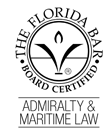Boat Operator Guilty of Running Over Scuba Diver
 The Associated Press reported that a Stuart, Florida Judge found a boat operator guilty of running over a scuba diver which severed the diver’s legs. The Palm Beach Gardens scuba diver was struck by boat propellers while diving about 4 miles north of the St. Lucie Inlet in January 2009. The diver testified he tried to get the boat operator’s attention by waving a spear gun above the surface, but no one acknowledged his signal. He then tried to swim out of the boat’s way, but the propeller struck his tank and legs. Judge Kathleen Roberts found the boat operator violated navigational rules, and sentenced him to six months probation on a misdemeanor charge.
The Associated Press reported that a Stuart, Florida Judge found a boat operator guilty of running over a scuba diver which severed the diver’s legs. The Palm Beach Gardens scuba diver was struck by boat propellers while diving about 4 miles north of the St. Lucie Inlet in January 2009. The diver testified he tried to get the boat operator’s attention by waving a spear gun above the surface, but no one acknowledged his signal. He then tried to swim out of the boat’s way, but the propeller struck his tank and legs. Judge Kathleen Roberts found the boat operator violated navigational rules, and sentenced him to six months probation on a misdemeanor charge.
Divers are routinely run over in the crowded waters of South Florida. The cause for such accidents is often times boat operators’ and/or the divers’ ignorance of navigational and diving rules. Below we explain some of the more common navigable rules applicable to dive situations.
Displaying a “Diver Down” Flag
First and foremost, divers are required to display a “diver down” flag when in the water. When diving in state waters, the diver need only display the well known red flag with a diagonal white strip. Florida law states the minimum size for any diver down flag displayed on a buoy or float towed by the diver is 12 inches by 12 inches. The minimum size for any diver down flag displayed from a vessel or structure is 20 inches by 24 inches. If the diver down flag is displayed from a vessel, it must be displayed from the highest point or such other location which provides that the visibility of the flag is not obstructed in any direction. The diver down flag must be lowered once all divers are aboard or ashore. Furthermore, no person may operate a vessel displaying a diver down flag unless the vessel has one or more divers in the water.
When the vessel is not under command, Federal law requires an Alpha flag not less than 1 meter in height be displayed. Federal law also requires measures be taken to ensure the Alpha flag can be visible without obstruction.
Staying Near the “Diver Down” Flag
Florida Law also requires divers to make reasonable efforts to stay within 100 feet of the diver down flag while diving in rivers, inlets and navigation channels and 300 feet of the diver down flag in all waters other than rivers, inlets and navigation channels.
Maintaining a Safe Speed Near a Dive Flag
Florida law imposes upon boat operators on waters other than rivers, inlets or navigation channels to make reasonable efforts to maintain a distance of at least 300 feet from a diver down flag. Any vessel other than law enforcement or rescue vessels that approaches within 100 feet of a diver down flag on a river, inlet, or navigation channel, or within 300 feet of a diver down flag on waters other than a river, inlet, or navigation channel, must proceed no faster than is necessary to maintain headway and steerageway.
Keeping a Lookout
Federal law requires every vessel at all times to maintain a proper lookout by sight and hearing as well as by all available means appropriate in the prevailing circumstances and conditions so as to make a full appraisal of the situation and of the risk of collision.
As we saw with the above case, there are criminal implications for failing to follow navigational rules. There are also civil ramifications. As these navigational rules are designed for safety, violation of them provide the injury party with the rebuttable presumption that the violation caused the injured. To overcome this presumption, the boat operator must not only prove that the violation did not cause the accident, but could not have caused the accident–something very hard to do.
Divers injured due to boat operators’ violation of navigational rules are entitled to fair and adequate compensation for damages experienced in the past and to be likely experienced in the future. Such damages include:
- Any bodily injury resulting in pain and suffering, disability or physical impairment, disfigurement, mental anguish, inconvenience, the loss of capacity for the enjoyment of life;
- The expense of hospitalization, medical and nursing care and treatment; and,
- Any earnings for work time lost.












